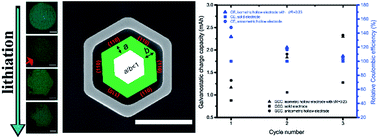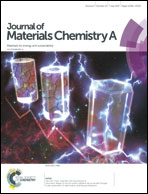Geometric design of micron-sized crystalline silicon anodes through in situ observation of deformation and fracture behaviors†
Abstract
Large anisotropic volume expansion during lithiation leads to the electrochemical performance degradation and premature fracture of micro-sized silicon electrodes in lithium-ion batteries, which prohibits its practical applications. To date, the failure mechanism of micron-size silicon electrodes has not been fully comprehended due to the lack of convincing experiments. For good understanding of lithiation/delithiation processes in the silicon anodes, in the present contribution, in situ observation of anisotropic volume expansion, crack initiation, penetration, deflection and delamination at the amorphous/crystalline silicon interface has been reported. The observation suggests that novel hollow and anisometric geometric electrodes have shown substantially enhanced capability in improving the fracture behaviors of the crystalline micropillar electrodes, implying that geometric design greatly impacts the strain alleviation and reversible volume change. Due to more favorable mechanical reliability, the anisometric geometric silicon electrode is expected to present essentially enhanced electrochemical performance and structural stability, which promises a novel strategy of designing Li-ion battery electrodes from a geometric perspective.



 Please wait while we load your content...
Please wait while we load your content...